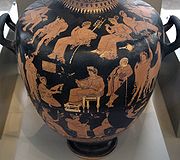
Varrese Painter
Encyclopedia

Apulia
Apulia is a region in Southern Italy bordering the Adriatic Sea in the east, the Ionian Sea to the southeast, and the Strait of Òtranto and Gulf of Taranto in the south. Its most southern portion, known as Salento peninsula, forms a high heel on the "boot" of Italy. The region comprises , and...
n red-figure
Red-figure pottery
Red-figure vase painting is one of the most important styles of figural Greek vase painting. It developed in Athens around 530 BC and remained in use until the late 3rd century BC. It replaced the previously dominant style of Black-figure vase painting within a few decades...
vase painter
Apulian vase painting
Apulian vase painting was the leading South Italian vase painting tradition between 430 and 300 BC. Of the circa 20,000 surviving specimens of Italian red-figure vases, about half are from Apulian production, while the rest are from the four other centres of production, Paestum, Campania, Lucania...
. His works are dated to the middle of the 4th century BC.
His conventional name is derived from the Varrese hypogeum
Hypogeum
Hypogeum or hypogaeum literally means "underground", from Greek hypo and gaia . It usually refers to an underground, non-Christian temple or a tomb...
(a rock-cut grave complex) at Canosa di Puglia, which contained several vases painted by him. In total, over 200 known vases are attributed to him. Scholars consider him one of the most important representatives of his period. His influence extended beyond his immediate surroundings and beyond his own phase of activity, as far as the immediate predecessors of the Darius Painter
Darius Painter
The Darius Painter was an Apulian vase painter and the most eminent representative at the end of the "Ornate Style" in South Italian red-figure vase painting...
. A quarter of the vases attributed to him, including hydriai, nestorids, loutrophoroi
Loutrophoros
A loutrophoros is a distinctive type of Greek pottery vessel characterized by an elongated neck with two handles. The loutrophoros was used to hold water during marriage and funeral rituals, and was placed in the tombs of the unmarried...
and a large oenochoe
Oenochoe
An oenochoe, also spelled oinochoe, is a wine jug and a key form of Greek pottery. There are many different forms of Oenochoe. The earliest is the olpe and has an S-shaped profile from head to foot.Oenochoe may be decorated or undecorated...
are of considerable size. The rest if his work is mainly on bell krater
Krater
A krater was a large vase used to mix wine and water in Ancient Greece.-Form and function:...
s and pelike
Pelike
A pelike is a one-piece ceramic container similar to an amphora.It has two open handles that are vertical on their lateral aspects and even at the side with the edge of the belly, a narrow neck, a flanged mouth, and a sagging, almost spherical belly....
s. Although he belongs to the tradition of the Ornate Style, his smaller vessels are often stylistically close to the Plain Style.
His pictorial repertoire is characterised by frequently repeated motifs. Four basic motifs have been identified:
- A naked youth, either standing with one arm covered by a garment, or seated on a folded cloth;
- A standing female figure, both legs clearly visible under her garment, one placed behind the other;
- A clothed woman, one of her feet standing on a higher level than the other, her upper body bent towards that foot, one arm resting on her thigh;
- A seated woman, placing one leg in front of the other.
The Varrese Painter's figures appear serious and sombre, their mouths are small and turned downwards. His women often wear their hair in a knot held by a white band. On his larger vases, especially when depicting funerary naiskoi, he makes copious use of additional colours. His large vessels usually show mythological
Greek mythology
Greek mythology is the body of myths and legends belonging to the ancient Greeks, concerning their gods and heroes, the nature of the world, and the origins and significance of their own cult and ritual practices. They were a part of religion in ancient Greece...
scenes. His smaller vases usually bear compositions of two or three figures on both sides, often including cloaked youths on the back.
The Varrese Painter's workshop also employed the Wolfenbüttel Painter; his influence has been noted not only on the predecessors of the Darius Painter
Darius Painter
The Darius Painter was an Apulian vase painter and the most eminent representative at the end of the "Ornate Style" in South Italian red-figure vase painting...
, but also on the Ginosa Painter, the Painter of Bari 12061, the Metope Painter, the Painter of Louvre MNB 1148 and the Chamay Painter.

